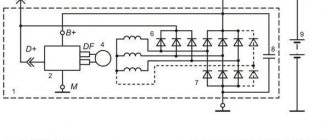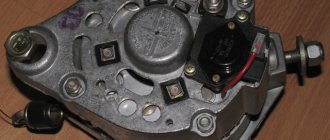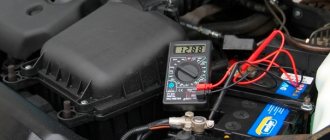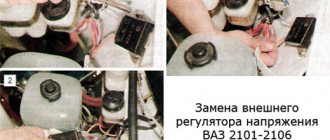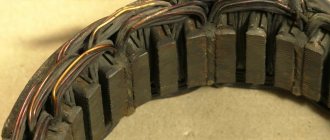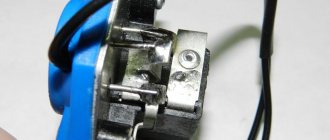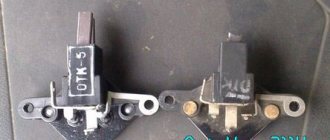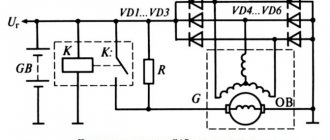Generator voltage regulator relay. Such a complex, at first glance, name refers to a very small component of a car or motorcycle generator, and whose failure can cause a number of problems. For example: undercharging or overcharging of the battery. This can happen for many reasons, but in most cases the culprit of the problem is a failed generator relay (as it is usually called). Let's figure out what a generator relay is, how this component is connected to the vehicle's on-board network, how to check it and, if necessary, replace it.
Basic automatic control processes
It doesn't matter what type of generator set is used in the car. In any case, it has a regulator in its design. The automatic voltage regulation system allows you to maintain a certain parameter value, regardless of the frequency at which the generator rotor rotates. The figure shows the generator voltage regulator relay, its diagram and appearance.
By analyzing the physics by which a generator set operates, it can be concluded that the output voltage increases as the rotor speed becomes higher. It can also be concluded that voltage regulation is carried out by reducing the current supplied to the rotor winding as the rotation speed increases.
Generator structure
Regardless of the make and model of the car, the type of car generator, a voltage regulator is always included in the design, allowing it to maintain operation regardless of the rotor speed. The adjustment is carried out by changing the strength of the electric current on the rotor winding.
Generator components (diagram):
- The stator (housing) is the stationary part of a car generator.
- There are three windings, they are connected into one by a star, which generates a three-phase alternating voltage.
- A rotor on the blades of which a magnetic field and EMF are formed.
- Three-phase rectifier - semiconductor diodes that convert voltage. One side of the diodes is conductive, the other has an insulated surface.
- Automatic voltage regulation device.
Car generator rotor
Three windings can significantly reduce ripple due to phase overlap.
What is a generator
Any car generator consists of several parts:
1. A rotor with an excitation winding, around which an electromagnetic field is created during operation.
2. A stator with three windings connected in a star configuration (alternating voltage is removed from them in the range from 12 to 30 Volts).
3. In addition, the design contains a three-phase rectifier consisting of six semiconductor diodes. It is worth noting that the VAZ 2107 generator voltage relay-regulator (injector or carburetor in the injection system) is the same.
But the generator will not be able to operate without a voltage regulation device. The reason for this is the voltage change over a very wide range. Therefore, it is necessary to use an automatic control system. It consists of a comparison device, control, executive, master and special sensor. The main element is the regulatory body. It can be either electrical or mechanical.
Main symptoms of a malfunction
There are two main “symptoms” of a relay failure. This is an undercharge or overcharge of the battery. Also, a malfunction of a part can be determined by the dim glow of the headlights or by a change in their brightness when the engine speed increases.
If undercharged, the car will start with great difficulty. However, the manifestation of this “symptom” may not be related to the generator. Therefore, first of all, you should make sure that the battery is in good condition.
If the battery is overcharged, there is no doubt that the problem lies precisely in the damaged relay. There are other possible causes of overcharging, but they are extremely rare. Overcharging may cause the battery to boil over. This can be determined by the decrease in the amount of electrolyte in the jars and the appearance of a white coating on the battery.
If you suspect that the battery is overcharged or undercharged, you should diagnose the generator.
Generator operation
When the rotor begins to rotate, some voltage appears at the generator output. And it is supplied to the excitation winding through a control element. It is also worth noting that the generator set output is connected directly to the battery. Therefore, voltage is constantly present on the excitation winding. When the rotor speed increases, the voltage at the generator set output begins to change. A voltage regulator relay from a Valeo generator or any other manufacturer is connected to the generator output.
In this case, the sensor detects the change, sends a signal to a comparing device, which analyzes it, comparing it with a given parameter. Next, the signal goes to the control device, from which it is supplied to the actuator. The regulatory body is able to reduce the value of the current that flows to the rotor winding. As a result, the voltage at the generator set output is reduced. In a similar way, the mentioned parameter is increased in the event of a decrease in rotor speed.
Features of the device and principle of operation
Generator type 37.3701 - alternating current, three-phase, with a built-in rectifier unit and an electronic voltage regulator, right-hand rotation (drive side), with a fan at the drive pulley and ventilation windows in the end part. To protect against dirt, the back cover of the generator is covered with a protective casing.
The operation of the generator is based on the effect of electromagnetic induction. If a coil, for example, made of copper wire, is penetrated by a magnetic flux, then when it changes, an alternating electrical voltage appears at the coil terminals. Such coils, placed in the grooves of the magnetic circuit (iron package), represent the stator windings - the most important stationary part of the generator - they are the ones that generate alternating electric current. The magnetic flux in the generator is created by the rotor. It also represents a coil (excitation winding) through which a direct current (excitation current) is passed. This winding is laid in the grooves of its magnetic core (pole system). The rotor, the most important moving part of the generator, also includes a shaft and slip rings. When the rotor rotates opposite the stator winding coils, the “north” and “south” poles of the rotor appear alternately, i.e., the direction of the magnetic flux penetrating the stator windings changes, which causes the appearance of alternating voltage in them. It would be possible to use a permanent magnet as a rotor, but the creation of magnetic flux by an electromagnet allows the generator output voltage to be easily adjusted over a wide range of rotation speeds and load current by varying the excitation current.
In order to obtain a constant voltage from an alternating voltage, six power semiconductor diodes are used, which together form a rectifier unit installed inside the generator housing.
The field winding is powered from the generator itself and is supplied to it through brushes and slip rings. To ensure the initial excitation of the generator, after turning on the ignition, current is supplied to terminal “B” of the voltage regulator through two circuits.
- Plus battery - contact 30 of the generator - contacts 30/1 and 15 of the ignition switch - contact 86 and 85 of the ignition relay winding - minus the battery. The relay turned on and the current flowed through the second circuit:
- Battery plus - contact 30 of the generator - contacts 30 and 87 of the ignition relay - fuse No. 2 in the fuse block - contact 4 of the white connector in the instrument cluster - 36 Ohm resistor in the instrument cluster - battery charging warning lamp - contact 12 of the white connector in the instrument cluster - contact 61 - terminal "B" of the voltage regulator - excitation winding - terminal "W" of the voltage regulator - output transistor of the voltage regulator - minus the battery.
After starting the engine, the excitation winding is powered from the common terminal of three additional diodes installed on the rectifier unit, and the voltage in the vehicle's electrical system is controlled by an LED or lamp in the instrument cluster. If the generator is working properly, after turning on the ignition, the LED or lamp should light up, and after starting the engine, it should go out. The voltage at the 30th pin and the common pin of 61 additional diodes becomes the same. Therefore, no current flows through the indicator lamp (LED) and it does not light up. If the lamp (LED) lights up after starting the engine, this means that the generator set is faulty, that is, it does not produce voltage at all, or it is lower than the battery voltage. In this case, the voltage at pin 61 is lower than the voltage at pin 30. Therefore, current flows in the circuit between them, passing through the LED/lamp. It/she lights up, warning that the generator is faulty.
Voltage regulator: purpose and principle of operation
The generator set is equipped with a semiconductor electronic voltage regulator built inside the generator. The voltage of a generator without a regulator depends on the rotation speed of its rotor, the magnetic flux created by the field winding, and, consequently, on the current strength in this winding and on the amount of current supplied by the generator to consumers. The higher the rotation speed and the excitation current, the greater the generator voltage; the greater the current of its load, the lower this voltage. The function of the voltage regulator is to stabilize the voltage when the rotation speed and load changes by controlling the excitation current.
Electronic regulators change the excitation current by turning on and off the excitation winding from the supply network (additional diodes). As the rotor speed increases, the generator voltage increases. When it begins to exceed the level of 13.5 ... 14.2 V, the output transistor in the voltage regulator is turned off and the current through the field winding is interrupted. The generator voltage drops, the transistor in the regulator unlocks and again passes current through the field winding. The higher the rotation speed of the generator rotor, the longer the time the transistor is in the locked state in the regulator, therefore, the more the generator voltage decreases. This process of locking and unlocking the regulator occurs at high frequency. Therefore, voltage fluctuations at the generator output are unnoticeable, and it can practically be considered constant, maintained at a level of 13.5...14.2 V.
Voltage regulator: purpose and principle of operation
The generator set is equipped with a semiconductor electronic voltage regulator built inside the generator. The voltage of a generator without a regulator depends on the rotation speed of its rotor, the magnetic flux created by the field winding, and, consequently, on the current strength in this winding and on the amount of current supplied by the generator to consumers. The higher the rotation speed and the excitation current, the greater the generator voltage; the greater the current of its load, the lower this voltage. The function of the voltage regulator is to stabilize the voltage when the rotation speed and load changes by controlling the excitation current.
Electronic regulators change the excitation current by turning on and off the excitation winding from the supply network (additional diodes). As the rotor speed increases, the generator voltage increases. When it begins to exceed the level of 13.5 ... 14.2 V, the output transistor in the voltage regulator is turned off and the current through the field winding is interrupted. The generator voltage drops, the transistor in the regulator unlocks and again passes current through the field winding. The higher the rotation speed of the generator rotor, the longer the time the transistor is in the locked state in the regulator, therefore, the more the generator voltage decreases. This process of locking and unlocking the regulator occurs at high frequency. Therefore, voltage fluctuations at the generator output are unnoticeable, and it can practically be considered constant, maintained at a level of 13.5...14.2 V.
Generator drive and mounting it to the engine
The generator is driven from the crankshaft by a belt drive using a V-belt. Accordingly, for this belt the generator drive pulley is made with one groove. To cool the generator, plates are spot welded on the back side of the pulley. On the pulley they are located almost perpendicularly and perform the function of a fan. The lower mounting of the generator on the engine is made on two mounting legs, articulated with the engine bracket with one long bolt and nut. The top one is through the pin to the tension bar.
Two-level regulators
A two-level automatic control system consists of a generator, a rectifier element, and a battery. It is based on an electric magnet, its winding is connected to the sensor. The driving devices in these types of mechanisms are very simple. These are ordinary springs. A small lever is used as a comparison device. It is mobile and makes switching. The actuator is the contact group. The control element is a constant resistance. Such a generator voltage regulator relay, the diagram of which is given in the article, is very often used in technology, although it is morally outdated.
Operation of a two-level regulator
When the generator operates, a voltage appears at the output, which is supplied to the winding of the electromagnetic relay. In this case, a magnetic field arises, with its help the lever arm is attracted. The latter is acted upon by a spring, which is used as a comparing device. If the voltage becomes higher than expected, the contacts of the electromagnetic relay open. In this case, a constant resistance is included in the circuit. Less current is supplied to the field winding. The voltage regulator relay for the VAZ 21099 generator and other domestic and imported cars operates on a similar principle. If the voltage at the output decreases, then the contacts are closed, and the current strength changes upward.
Electronic regulator
Two-level mechanical voltage regulators have a big drawback - excessive wear of the elements. For this reason, instead of an electromagnetic relay, semiconductor elements operating in key mode began to be used. The operating principle is similar, only the mechanical elements are replaced by electronic ones. The sensing element is made on a voltage divider, which consists of constant resistors. A zener diode is used as a driving device.
The modern relay-voltage regulator of the VAZ 21099 generator is a more advanced device, reliable and durable. The executive part of the control device operates on transistors. As the voltage at the generator output changes, the electronic switch closes or opens the circuit, and additional resistance is connected if necessary. It is worth noting that two-level regulators are imperfect devices. Instead, it is better to use more modern developments.
Three-level regulation scheme
The quality of battery charging depends on the efficiency of the voltage regulator. When not fully charged, the battery loses capacity at a high rate, and subsequently it becomes impossible to start the engine.
Three-level voltage regulator
Two-level models have a big drawback - the spread of the output voltage. Therefore, to increase the stability of the system, a three-level adjustment system is used, which includes a toggle switch (changes the system parameters).
The use of this type of model allows for more accurate diagnostics and control of the potential at the output of the generator, which is important for new models of the mid-price level, where manufacturers do not always use high-quality mechanisms.
The most relevant use of this system is in the winter season in regions with cold climates, when low temperatures greatly reduce the battery capacity. Mechanical regulators have been replaced by non-contact three-level, more advanced ones.
The circuit and principle of operation are similar to two-level models, except that the voltage first goes to the information processing unit. If there is a deviation from the operating value, a sound signal (mismatch) is given. After this, the electric current supplied to the winding changes to the operating value.
Installation principle
It is allowed to install three-level models in any car yourself, provided you know the connection diagram:
- It is necessary to disconnect the brush assembly by unscrewing the bolts.
- Install the semiconductor assembly on the car body, making the necessary fastenings.
- The semiconductor assembly is installed first on an aluminum radiator, because requires efficient cooling and is then secured to the case.
If there is no cooling system, regulation will not occur correctly.
- After installing the two units, it is necessary to ensure an electrical connection between them with wires, ensuring high-quality insulation of the housings.
Surfaces must be covered with insulating material to prevent short circuits to the housing. A switch should be provided for switching semiconductors.
To install the structure, a housing is required. Usually plastic or aluminum is used, which has greater heat transfer, i.e. cooling will occur more efficiently.
Three-level regulation system
The quality of regulation of such structures is much higher than that of those previously discussed. Previously, mechanical designs were used, but today non-contact devices are more common. All elements used in this system are the same as those discussed above. But the operating principle is slightly different. First, voltage is applied through a divider to a special circuit in which information is processed. It is possible to install such a generator voltage regulator relay (Ford Sierra can also be equipped with similar equipment) on any car if you know the device and connection diagram.
Here the actual value is compared with the minimum and maximum. If the voltage deviates from the value that is set, then a certain signal appears. It is called a mismatch signal. It is used to regulate the current flowing to the excitation winding. The difference from a two-level system is that there are several additional resistances.
Characteristics of the voltage regulator
New and old regulator relay
How much voltage should the generator produce, what types of remote relays are there, how does the element work? What are the signs of a malfunction, how to increase or increase the output, what to do if the voltage jumps? First of all, it is necessary to understand the issues of design and purpose.
Purpose
So, what are the signs of a malfunction, what functions does a three-level voltage regulator perform? When the engine of any car starts, first of all, under the influence of direct current, the crankshaft begins to work. It is because of the direct current that it begins to set the movement of the rotor, and only after these actions does the car generator directly begin to work. A three-level voltage regulator monitors all these processes; this element is also often called a DC relay.
Without this device, the current in the on-board network will not be able to start the generator itself into operation, especially since the current supply will not be controlled. In addition, a three-level voltage regulator allows you to keep the current within a certain range.
Design
General scheme of operation
Even the simplest and homemade regulator should be able to optimally regulate voltage, which is achieved as a result of the operation of the rotor. As a rule, in modern cars the rotor rotates to the right, but there are exceptions.
Any generator voltage regulator, even a homemade and simple one, will consist of the following components:
- Impeller. This component is mounted on the outside of the device. Its purpose is to blow and further cool the winding.
- The housing cover is designed to close access to the internal components of the device in order to protect the structure from dirt, dust and other debris. In addition, the lid can be additionally equipped with a casing. If there is a casing, the regulator itself will be installed behind it.
- Rectifier device. This circuit consists of several diodes. As a rule, there are six diodes. It should be noted that all diodes of the circuit are connected to each other via a so-called bridge.
- Rotor with winding. This component rotates around an axis, so the rotor must produce a magnetic field in the housing.
- The stator is another circuit component. On the stator housing there are three windings that are connected to each other. These circuit windings make it possible not only to supply a large amount of charge and power to the battery, but also to provide direct current to the entire on-board circuit of the machine.
- Directly relay. Thanks to an automotive relay, the circuit can maintain an optimal voltage level in the required range. The voltage should not be too high - it is always optimal (video author - Nikolay Purtov).
How much power in amperes should the car regulator produce after connection? The voltage generation circuit is carried out according to a certain principle. As a result of rotor rotation, the field winding is always exposed to a small voltage while the generator is connected to the battery. While rotation occurs, alternating current appears at the terminals and flows into the winding. The rotation of the rotor is ensured by the generator belt.
How much energy this device should produce is a secondary question, because when this energy is generated, first of all, a large voltage must be rectified. Diode bridges are used for this purpose. Since the voltage is high, the electronic voltage regulator comes into play. This component responds to changes in current that occur in the circuit, and then sends this information to a comparison device designed to analyze the required readings with those that were received. If the voltage at the generator terminals becomes lower, the regulator begins to increase the level of direct current in the circuit, raising it to the required level.
Principle of operation
If you connect a winding without a regulator to the power source, the DC level will be too high. Thanks to the relay in the diagram, this parameter is equalized to prevent equipment failure. The regulator itself is essentially a switch. If the current level increases to 13.-14 volts, the device automatically disconnects the winding from the network and turns it on if the current level is too low. As a result, the wiring is regularly switched at a high frequency; accordingly, the generator can produce a higher voltage (video author - Alex ZW).
Varieties
To connect to the vehicle's on-board circuit, there are several types of regulators designed to operate under direct current in amperes. It should be noted that some of them are characterized by certain malfunctions. But, as practice shows, in most cases, the malfunctions of these devices are usually identical to each other. Before we talk about how to check the DC voltage regulator in a car and how to identify faults, let’s pay attention to the types.
This way you can understand which type is better:
- The two-level type is obsolete, but our car enthusiasts continue to use it today. These regulators are based on an electromagnet that is connected to a winding sensor. Springs act as setting elements, and the function of a comparing component is performed by a movable lever. Its dimensions are quite small, and it is used to perform switching. The main drawback, which often leads to malfunction, is the device’s short lifespan.
- Electronic devices rated at 40 amps are considered semiconductor devices. They are characterized by a long service life; accordingly, owners of cars with electronic regulators encounter malfunctions less often.
- Three-level structures in their structure are practically no different from those that we have already considered. The only fundamental difference is that such devices are equipped with additional resistance.
- Multi-level is another type. Some experts believe that such regulators are better than others, since they are equipped with three or even five additional resistances. In addition, there are models that can operate in tracking mode.
The cost of regulators may vary depending on the type and model. Which one is better to buy is entirely up to everyone. On average, the cost of such elements varies around $5. If your budget allows, it is better to purchase two regulators at once. Why is it better? Because this part is indispensable on the road.
Modern voltage regulation systems
If the voltage regulator relay for the generator of a Chinese scooter is two-level, then more advanced devices are used on expensive cars. Multilevel control systems can contain 3, 4, 5 or more additional resistances. There are also tracking automatic control systems. In some designs, you can refuse to use additional resistances.
Instead, the frequency of operation of the electronic key increases. It is simply impossible to use circuits with electromagnetic relays in servo control systems. One of the latest developments is a multi-level control system that uses frequency modulation. In such designs, additional resistances are required, which are used to control logic elements.
Checking the functionality of the regulator
On almost all car models, the regulator relay is diagnosed in the same way. To carry out diagnostics, you need a constant voltage source (battery, batteries), a 12 V lamp or a voltmeter.
The minus contact is connected to the device plate, the plus contact is connected to the regulator relay connector.
After removing the regulator from the body, it is necessary to check the functionality of the brushes. If they are less than 5mm in length, then the brush assembly must be replaced.
An incandescent lamp must be included in the circuit between a pair of brushes:
- the extinguishing of the light bulb as the voltage increases indicates the serviceability of the device;
- Constant lighting of the light when changing parameters indicates a malfunction of the voltage regulator.
Soldering new brushes will not bring results, because... the reliability of the design will be significantly reduced. It is unacceptable to use LED products for testing, because Carrying out diagnostics according to this scheme will not give real results.
Test without stress relief
It consists of measuring the on-board voltage in the car. The presence of surges in the network is also determined by the blinking of the lamps during the trip. To check, you will need a multimeter (or a regular incandescent lamp). A multimeter allows you to get more accurate results.
Procedure:
- Start the engine, turn on the headlights.
- Connect the measuring device to the battery.
- The operating voltage ranges from 12 to 14.8 V. If the voltage regulator goes beyond this range, it is considered faulty.
Testing under voltage does not determine the condition of the brush assembly. Exceeding the operating voltage parameters may be associated with weakening or oxidation of contacts.
The operation of control systems in cars is being improved. For modern cars there is no point in using two-level regulation. More advanced systems have 2 or more additional resistances. In new models, instead of the traditional additional resistance, the principle of increasing the frequency of operation of the electronic key is used.
Along with the classical ones, automatic servo control systems are used, in which there is no electromagnetic relay.
The most common method is a three-level frequency modulation control circuit to control logic elements.
How to remove the relay regulator
Removing the generator voltage regulator relay (“Lanos” or domestic “nine” is not important) is quite simple. It is worth noting that when replacing the voltage regulator, you only need one tool - a flat-head or Phillips screwdriver. There is no need to remove the generator or the belt and its drive. Most of the devices are located on the back cover of the generator, and are combined into a single unit with a brush mechanism. The most common breakdowns occur in several cases.
Firstly, when completely erasing the graphite brushes. Secondly, in case of breakdown of a semiconductor element. How to check the regulator will be discussed below. When removing, you will need to disconnect the battery. Disconnect the wire that connects the voltage regulator to the generator output. By unscrewing both mounting bolts, you can pull out the device body. But the voltage regulator relay for the VAZ 2101 generator has an outdated design - it is mounted in the engine compartment, separately from the brush assembly.
How to test a relay with a lamp
On many modern cars, the relay is combined with brushes. In this case, you can check the regulator using an incandescent lamp. The procedure will be as follows:
- To get to the part, you need to unscrew the mounting bolts and remove the terminals. The relay is located at the rear of the generator.
- To check, you need to prepare a 12V light bulb with a socket, wires, a voltmeter, and a power supply (no more than 20V).
- Next you will need to assemble the following circuit.
- After connecting the light bulb, it should light up. At the same time, the voltage gradually increases. When it reaches 14.5V, the light should go out. If this happens later, it means the relay regulator is faulty.
When the voltage decreases, the lamp should light up again.
This test method can also be used for some models of regulators that are not combined with brushes.
Device check
The relay-regulator of the voltage of the VAZ 2106 generator, “kopecks”, and foreign cars is checked equally. As soon as you remove it, look at the brushes - they should be more than 5 millimeters long. If this parameter is different, the device must be replaced. To carry out diagnostics, you will need a constant voltage source. It would be desirable to be able to change the output characteristic. You can use a battery and a couple of AA batteries as a power source. You also need a lamp, it must run on 12 Volts. You can use a voltmeter instead. Connect the plus from the power supply to the voltage regulator connector.
Accordingly, connect the negative contact to the common plate of the device. Connect a light bulb or voltmeter to the brushes. In this state, voltage should be present between the brushes if 12-13 Volts are supplied to the input. But if you supply more than 15 Volts to the input, there should be no voltage between the brushes. This is a sign that the device is working properly. And it doesn’t matter at all whether the voltage regulator relay of the VAZ 2107 generator or another car is diagnosed. If the control lamp lights up at any voltage value or does not light up at all, it means that there is a malfunction of the unit.
Do-it-yourself diagnostics of the voltage regulator
How to check a car's voltage regulator to identify faults with your own hands? What is better to measure with your own hands - amperes or volts, which is better to use. To identify faults with your own hands, you need to use a multimeter or voltmeter. It is necessary that the device has a scale for measuring 15-30 volts. Do-it-yourself diagnostics of car relay faults at 40 amperes or lower using a multimeter should only be done with a charged battery.
Diagnosing a failed relay using a voltmeter
- First you need to turn on the ignition.
- Start the engine yourself, let it run, while turning on the headlights. Let the engine run until the number of revolutions is about 2.5-3 thousand. As a rule, this requires waiting about 10 minutes.
- Using a voltmeter, measure the voltage at the battery terminals. The parameter should be about 14.1-14.3 volts.
If during diagnostics the indicators turn out to be lower or higher, it is better to purchase a new 40 amp relay. During diagnostics, the plugs should never be bridged, as this can lead to deformation and inoperability of the rectifier unit. To obtain more accurate readings, you need to make sure that the alternator belt is well tensioned.
conclusions
In the electrical system of a car, the voltage regulator relay of the Bosch generator (as, indeed, of any other company) plays a very important role. Monitor its condition as often as possible and check for damage and defects. Cases of failure of such a device are not uncommon. In this case, in the best case, the battery will be discharged. And in the worst case, the supply voltage in the on-board network may increase. This will lead to the failure of most electricity consumers. In addition, the generator itself may fail. And its repair will cost a tidy sum, and considering that the battery will fail very quickly, the costs will be astronomical. It is also worth noting that the Bosch generator voltage regulator relay is one of the leaders in sales. It has high reliability and durability, and its characteristics are as stable as possible.
Video. Generator in a car
The voltage regulator occupies one of the key places in the car circuit. It is necessary to constantly monitor the condition of the device, carry out scheduled inspections in a timely manner, and clean the contacts (to prevent malfunctions). Because The part is located on the lower side of the engine compartment, not protected from dust and moisture; regularly clean the surfaces from dirt.
If there are external defects or damage, you should not use such devices, because in this case, a rapid discharge of the battery or complete failure of the car generator, as well as the electrical part of the car (due to a sharp increase in voltage in the on-board network), is possible.
You should choose reputable brands, because... The voltage regulator must be as stable, durable and reliable as possible.
Rate this article:



